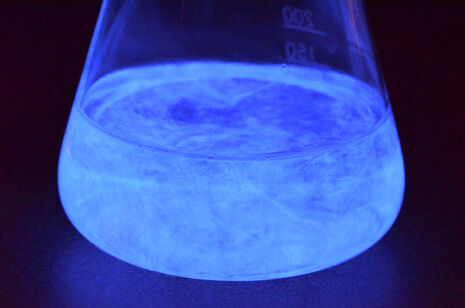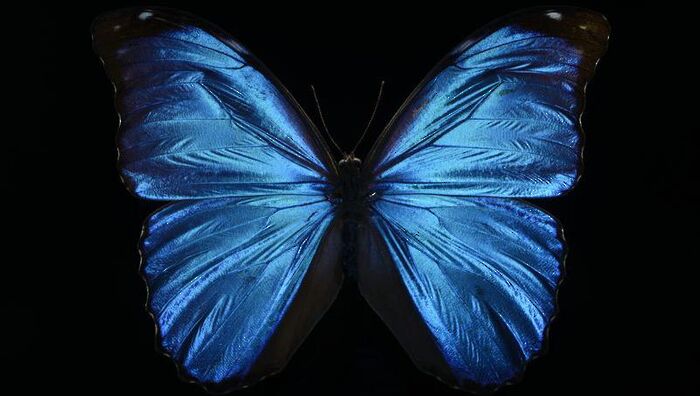From Cambridge blue to bioluminescence
Arguably the most commonplace colour in our city, it’s surprising that nobody actually knows what colour Cambridge blue is

Despite the ‘Cambridge Blue’ colour being commonplace in our city, there is no actual agreement on the exact formulation of the colour. Although the University guidelines recommend the specific combination of red, green, and blue, the shade adopted by the Cambridge University Boat Club differs from that chosen by the University’s Rugby Union Football Club. Surprisingly, according to the Pantone system – a proprietary colour classification scheme widely used in the paint and printing industries – the official Cambridge Blue falls into the ‘spring green’ category.
Cambridge teams’ kit and our clothes get their colour from pigments, chemical compounds that absorb some wavelengths and reflect others. In the past, blue was very expensive colour as it could only be created by crushing the rare minerals lapis lazuli and azurite together, before mixing with a binding agent such as egg yolk or linseed oil. Medieval stained glass instead features cobalt, as does traditional Chinese porcelain. However, during the Renaissance, blue dyes became more affordable thanks to the woad being imported, a plant whose fermented leaves produce an indigo pigment. By 1570, this dye had grown so popular that Pope Pius V removed it from list of authorised colours for ecclesiastical clothing as he believed it to be too common. Since the early 1800s, artificial blue dyes have replaced mineral and plant-based pigments. Inks are typically coloured with phthalocyanine while the clothing industry mostly relies on the use of synthetic indigo dyes, with up to 3% of blue jeans’ weight coming from pigments.
Light scattering answers the years-old question of why the sky is blue
In nature we observe blue in a number of animals, such as butterflies and birds, and even in eyes. In the vast majority of natural cases, the blue colouration is due to light scattering. Small particles (500 nm and smaller) tend to scatter blue light more efficiently, while they let though the other colours and thus appear blue. This type of scattering is known as Rayleigh scattering after Lord Rayleigh, the second Cavendish Professor of Physics at the University of Cambridge.

This answers the years-old question of why the sky is blue. Rayleigh scattering is partly responsible, as air molecules and dust tend to scatter blue more strongly than other wavelengths. Nevertheless, this alone cannot be the cause: a dense uniform substance, like the middle of the atmosphere, does not scatter laterally very efficiently. In fact, in 1910 Marian Smoluchowski and Albert Einstein independently came to the conclusion that the thermal motion of the air gives rapid density fluctuations to cause the molecules to cluster and align preferentially in one direction, producing a similar effect to Rayleigh scattering.
A different blue-producing mechanism is used by bioluminescent marine creatures, with the bright colouration attributed to a chemical reaction between a light-emitting molecule and an enzyme catalyst. The biological function of luminescence can vary from attracting mates to providing a warning sign, scaring away possible predators, who have learnt that that colour is associated with an unpalatable prey.
Nowadays, it is also possible to synthesise artificial chemiluminescent compounds such as luminol, which is commonly used by forensic investigators to detect blood traces: in contact with the iron in hemoglobin luminol reacts to give a blue glow which can last a few seconds – enough to frame a murderer.
 News / Uni Scout and Guide Club affirms trans inclusion 12 December 2025
News / Uni Scout and Guide Club affirms trans inclusion 12 December 2025 News / Cambridge Vet School gets lifeline year to stay accredited28 November 2025
News / Cambridge Vet School gets lifeline year to stay accredited28 November 2025 Science / Did your ex trip on King’s Parade? The science behind the ‘ick’12 December 2025
Science / Did your ex trip on King’s Parade? The science behind the ‘ick’12 December 2025 News / Cambridge study finds students learn better with notes than AI13 December 2025
News / Cambridge study finds students learn better with notes than AI13 December 2025 News / Pembroke to convert listed office building into accom9 December 2025
News / Pembroke to convert listed office building into accom9 December 2025








